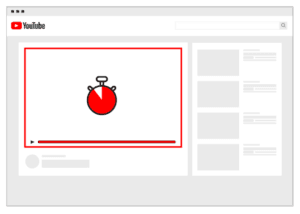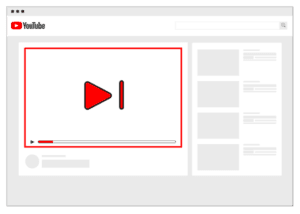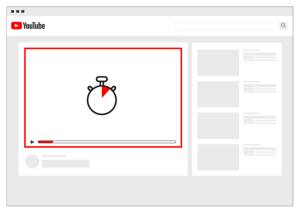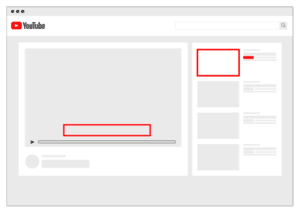WELCOME BACK!
In Part 1 of this series, you learned about YouTube advertising and how it can empower colleges and universities to connect with their communities. Now, let’s take a look at four different video ad formats currently available on YouTube, six quick tips for creating great video content, and how to get started with your first ad.
TYPES OF YOUTUBE ADS
YouTube allows for a range of video ad formats to engage viewers in different ways and at different points in their journey. As a savvy marketer, it’s up to you to decide which of these ad formats best fits where your ideal prospect may be along the way. Below, we’ll preview four different ad types and provide a recommendation for an easy format to get started with your first ad.

1. Non-Skippable In-Stream Ads: Appearing before, during, or after other videos on YouTube, this video ad format gives you up to 15 uninterrupted seconds to make your best pitch. It’s a solid choice if you’re looking to promote a new program or a major event at your institution. Providing a tempting CTA will capitalize on the viewer’s attention. This is the ad format we recommend for marketers to try first.
These ads use target CPM (cost per mille) bidding, so you pay for every thousand impressions your ad receives.

2. Skippable In-Stream Ads: These video ads also play before, during, or after YouTube videos, but after five seconds, the viewer can skip the ad. The good news: even skippers are 10 times more likely to take action than those who don’t see the ad. These ads are ideal if your video is longer than 15 seconds.
With this format, you have a few different bidding options. With CPV (cost per view) bidding, you pay when a viewer watches at least 30 seconds of your video (or the whole thing if it’s shorter than 30 seconds) or interacts with your video – whichever comes first. With target CPM, target CPA (cost per action), and maximize conversions bidding, you pay based on impressions.

3. Bumper Ads: Bumper ads are similar to non-skippable in-stream ads, but they’re six seconds or shorter. It’s a real challenge and a valuable opportunity to distill your message down to a single, memorable nugget – or to create a curiosity gap that piques the viewer’s interest to discover more.
As with non-skippable in-stream ads, bumper ads use target CPM bidding.

4. In-Feed Video Ads: These video ads appear at the top of the YouTube search results for your category and in other places as recommendations to viewers. They consist of a thumbnail image and a short snippet of text that links to a full video. This format lets you promote longer-form content – like a student testimonial or how-to-apply guide– alongside videos being watched by your target audience.
With this format, you’ll be charged only when viewers click the thumbnail image to watch your video.
TIPS FOR CREATING COMPELLING YOUTUBE ADS
While there are no one-size-fits-all rules when it comes to crafting content that really works, there are best practices to make sure your video ad content resonates with the viewer. Going back to basics, make sure you remember the 4 P’s: Product, Price, Promotion, and Place.
- Set Your Intentions: To launch a successful YouTube ad campaign, you need to have a clear understanding of who you want to reach and what action you want them to take. Whether it’s driving interest in a new hybrid learning program or boosting general enrollment, a well-defined goal will enable you to strike the right tone and pick the right formats.
- Consider User Experience: You’ll probably be creating content on a desktop computer, but bear in mind that 70% of users (and counting) access YouTube on their phones. Use tighter framing, larger text, and boosted brightness and contrast for optimal mobile viewing. And don’t neglect audio – 95% of YouTube videos are played with sound on.
- Start Strong: YouTube recommends that you grab your audience’s attention immediately and introduce your brand or program within the first five seconds. A common mistake that brands make is waiting too long to deliver the “hook.”
- Unleash the Emerging Story Arc: YouTube is also challenging ad creators to rethink the traditional bell-curve storytelling arc that’s commonly seen in TV commercials and instead adopt a heartbeat narrative structure, where a strong opening is followed by subtle brand cues, unexpected shifts, multiple peaks, and, finally, more story for those who want it.
- Show Real, Relatable People: Human faces attract immediate interest, heighten emotional investment, and boost engagement. You can allow current students and alumni to show – rather than tell – how attending your school has positively impacted their lives.
- Clarify Your CTA: Regardless of what ad format you choose, you need a CTA that encourages viewers to interact with your brand. A generic appeal like “Click Here” won’t get many clicks compared to “Apply Online Now” or “Learn More About Online Degree Programs.” And don’t leave your brand cue to the very end.
Now that you’re in the know on YouTube advertising, you’re ready to roll. All you need to run a YouTube ad is a video that’s already hosted on YouTube, a Google Ads account, and a budget. If you’re still feeling overwhelmed, reach out to the LIGHTSTREAM team. For over 15 years, LIGHTSTREAM has helped dozens of colleges and universities across the nation to develop cutting-edge marketing strategies incorporating the best of traditional and new media – including dynamic YouTube ad campaigns. Are you ready to take your brand to the next level? Get in touch today.

